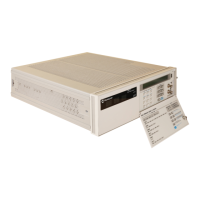Appendix B Glossary
5071A Glossary
160 Operating and Programming Manual
5071A Glossary
Accuracy The degree to which the 5071A
output frequency differs from that of the
accepted definition. The currently-accepted
definition is that of the 13th General
Conference of Weights and Measures and is
based on Cesium (The hyperfine resonance
of the Cesium 133 atom in zero magnetic
field is 9.192631770 GHz.). In practice, this
involves comparison with some generally-
accepted physical embodiment of this
definition such as one of the time standards
in the international time scale (TIA)
monitored by the BIH (Bureau International
L‘Heure) in Paris, France. The specified
accuracy of the 5071A is intrinsic and is
maintained without calibration.
Epoch (Time) A selected instant in time,
used as a reference point.
Flicker Floor The level at which the Allan
variance time domain stability measurement
remains constant with increased averaging
time. The Allan Variance statistical method
for measuring time domain stability responds
in several ways to various noise processes in
a cesium standard. Many of these noise
processes produce contributions which
average out or decrease as the averaging time
increases. Flicker noise, on the other hand,
gives rise to an Allan variance independent
of averaging time. Thus, the Allan variance
of a typical frequency standard will decrease
with increasing time, until a relatively
constant value is reached. This value is
known as the flicker floor.
Frequency Domain Stability (also called
single-sideband phase noise or additive
noise). Describes
the spectral noise in the specified output
signal caused by phase modulation from
internal noise sources. The measurement is
normalized by expressing the ratio of noise
power (in a 1-Hz bandwidth) to the signal
power, then measured as a function of offset
from that signal.
For more information see NIST Technical
Note 1337, Characterization of Clocks and
Oscillators available from the Superintendent
of documents, U.S. Government Printing
Office, Washington DC 20402-9325.
Isolation The degree to which one output of
the 5071A is affected by changes in loading
on another output of the same standard. In
practice, this represents a change in
amplitude, frequency, or phase as seen at one
terminal due to the effect of placing a short,
open, or reactance on another terminal. In the
5071A, both the Port 1 and Port 2 high
isolation output frequencies are derived from
the same source; there is no measurable
change in frequency. The change in amplitude
or phase is measured as the level of the
sideband at one port, which results from
applying and removing the load at a low
frequency rate at the other port. The
measurement is the level of the resulting
sideband compared to the nominal output
level, expressed in decibels.
Reproducibility The degree to which the
5071A will reproduce the same frequency
from one occasion to another after an
interruption in operation. This does not
include any calibration procedure but may
require degaussing.

